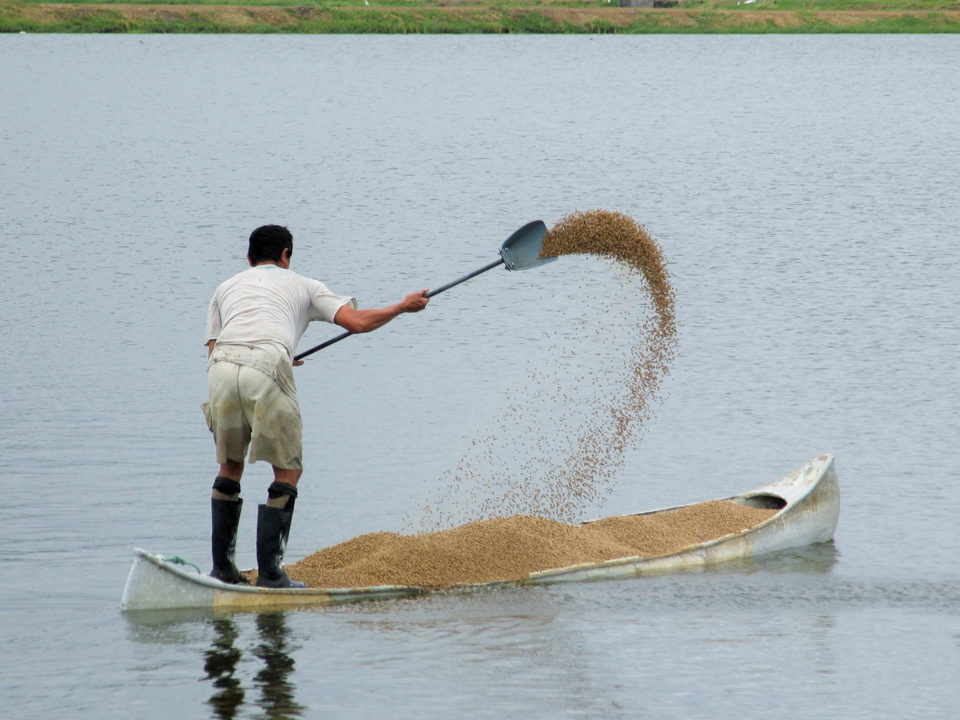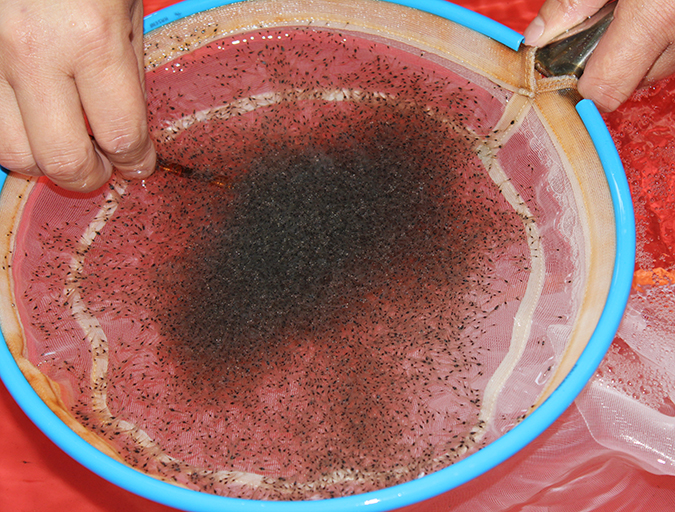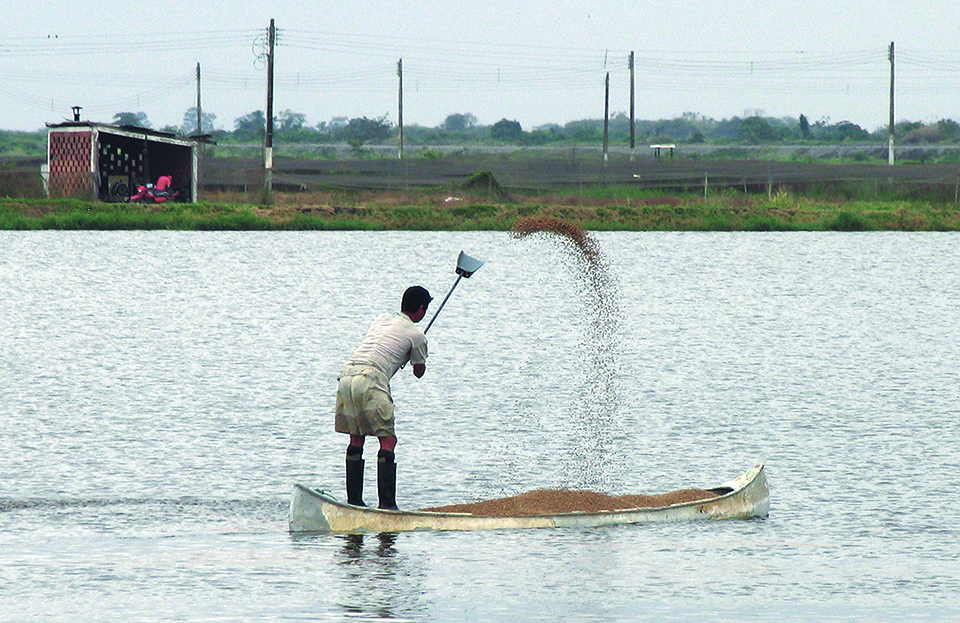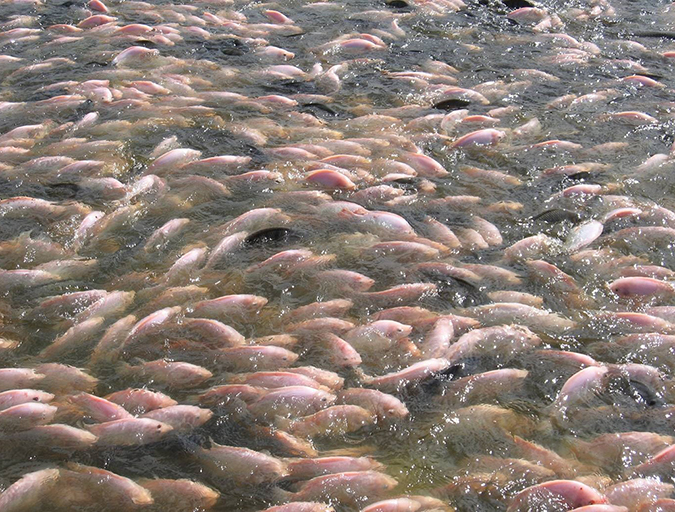Understanding the fate of aquafeeds and environmental waste loads

Ammonia nitrogen consists of ammonia (NH3) and ammonium (NH4+), but methods of measuring ammonia nitrogen concentration do not distinguish between the two forms. The results usually are reported as total ammonia nitrogen (TAN) concentration, which means the concentration of nitrogen resulting from the nitrogen in ammonia (NH3-N) and ammonium (NH4+-N) combined.
The two forms of nitrogen exist in a pH and water temperature dependent equilibrium:
NH3+ H+= NH4+
which may also be written as
NH3+ H2O = NH4++ OH–.
When the hydrogen ion (H+) concentration decreases, hydroxide ion (OH–) concentration and pH increase, and the ratio of ammonia:ammonium increases, and greater temperature increase also favors a larger proportion of ammonia.
This proportion of ammonia:total ammonia nitrogen is of importance in aquaculture, because ammonia is toxic while ammonium is not appreciably toxic. The combination of high pH and elevated total ammonia nitrogen concentration can lead to elevated ammonia concentrations potentially harmful to culture animals.
Total ammonia nitrogen concentration may be measured by wet chemistry procedures, test kits and electronic meters. The ammonia concentration must be calculated from the total ammonia nitrogen concentration by aid of the equilibrium constant for one of the reactions shown above, pH, and water temperature. Alternatively, factors from Table 1 may be multiplied by total ammonia nitrogen concentration to give the ammonia concentration as the amount of nitrogen in ammonia (NH3-N). An even easier way of making the calculation is to avail of online ammonia calculators such as the one found at www.hbuehrer.ch/Rechner/Ammonia.html.
Ammonia toxicity
There are many data on the toxicity of ammonia to fish and shrimp from laboratory tests in which pH and ammonia concentration were constant. The LC50 concentrations (concentrations required to kill 50 percent of test animals) have the following ranges: 0.3 to 0.9 mg/L for coldwater fish; 0.7 to 3.0 mg/L for warmwater fish; 0.6 to 1.7 mg/L for marine fish; and 0.7 to 3.0 mg/L for marine shrimp. Safe concentrations for long-term exposure are around 0.015 to 0.045 for coldwater fish and about 0.05 to 0.15 for warmwater and marine fish and shrimp. In aquaculture systems, pH and temperature vary during the day, and fish and shrimp in culture systems are not exposed to a constant ammonia concentration.
A study done by Hargreaves and Kucuk on three species of fish exposed to a daily cycle of pH and temperature such as observed in ponds revealed that exposure to relatively high ammonia concentrations for a few hours each day was not harmful. Moreover, ponds often contain 2 to 5 mg/L of total ammonia nitrogen, but negative effects on fish are seldom discernable. The author has never seen a fish kill in aquaculture ponds that could be definitely attributed to high ammonia concentration, but he does not imply that high ammonia concentration does not often stress fish.
The upshot is that high ammonia concentrations in aquaculture are likely to stress fish but seldom kill them. Shrimp tend to stay at the bottom of ponds where pH and temperature tend to be lower, but in well-mixed, aerated ponds, the pH and temperature near the bottom usually are about the same as in surface water.
Sources in aquaculture
The major sources of ammonia in aquaculture ponds are fertilizers and feeds, and problems with high ammonia are most common in feed-based aquaculture. Ammonia is excreted by culture animals as a waste product from protein metabolism, and microbial decomposition of organic matter also is a source of ammonia. Ammonia concentrations tend to increase as feed input increases in response to greater production.
There are some natural controls on total ammonia nitrogen concentration in ponds. The two main ones are uptake of ammonium by phytoplankton and oxidation of ammonia nitrogen to nitrate by nitrifying bacteria. Ammonia is a gas that can diffuse into the air when pH is elevated, and diffusion is a minor loss of ammonia from ponds on windy days and in heavily aerated ponds. Of course, outflowing water removes ammonia, and small amounts of ammonium may be adsorbed on cation exchange sites in bottom soil.
Management to control ammonia
As to management methods to control ammonia, there are several. The most important ones are to use feed that has no more protein than necessary, feed conservatively, avoid uneaten feed, obtain a low feed conversion ratio, and prevent low dissolved oxygen concentrations. Animals feed better when not stressed by low dissolved oxygen concentration, and nitrification is inhibited at less than 3 to 4 mg/L dissolved oxygen.
In an emergency with high ammonia concentration, flushing a pond at a rate of 30 to 50 percent of pond volume per day can remove ammonia. There is no evidence that treatment with bacteria amendments (often called probiotics) lowers total ammonia nitrogen concentration. Moreover, zeolite does not remove ammonium from pond water effectively because other dissolved cations greatly outnumber ammonium and compete with ammonium for adsorption sites on zeolite.
In water recirculating systems, biofilters are used to remove ammonia nitrogen from water by nitrification. It is critical to keep dissolved oxygen at concentrations above 3 to 4 mg/L in biofilters to avoid decreasing the rate of nitrification. In biofloc aquaculture systems, ammonia nitrogen is controlled, to some extent, by nitrification but because of high concentrations of total ammonia nitrogen in these systems, a carbohydrate source often is applied to encourage biofloc formation through bacterial growth. Bacteria remove ammonia nitrogen for use in producing new bacteria cells as will be discussed in more detail in another article.
In raceway culture, ammonia concentration is more likely to be a negative factor where water has a naturally-elevated pH – especially pH above 8. Ammonia control can be effected by maintaining a reasonable feeding rate and sufficient water flow through raceways.
In cage culture, water currents passing continuously replaces water of higher ammonia concentration in cages with water of lower concentration. Of course, if the water body containing cages has high ammonia nitrogen concentration and pH, there is no way of lessening the exposure of fish to ammonia.
Perspectives
The likelihood of severe ammonia limitations on aquaculture production would be much greater in water-recirculating and biofloc aquaculture systems than in ponds without these control methods. However, negative impacts of ammonia in all culture systems are probably not as frequent and severe as often thought.
Author
-

Claude E. Boyd, Ph.D.
School of Fisheries, Aquaculture and Aquatic Sciences
Auburn University
Auburn, Alabama 36849 USA[117,100,101,46,110,114,117,98,117,97,64,49,101,99,100,121,111,98]
Tagged With
Related Posts

Health & Welfare
Ammonia toxicity degrades animal health, growth
Ammonia nitrogen occurs in aquaculture systems as a waste product of protein metabolism by aquatic animals and degradation of organic matter, or in nitrogen fertilizers. Exposure can reduce growth and increase susceptibility to diseases in aquatic species.

Health & Welfare
Acclimating shrimp postlarvae before pond stocking
Shrimp postlarvae acclimation before stocking into the various growout systems (ponds, raceways, tanks) is a critical – and often overlooked, sometimes taken for granted – step in the shrimp culture process. Various water quality parameters should be changed slowly so that the young shrimp have the time to gradually adapt to the new conditions.

Aquafeeds
Aquaculture feed composition helps define potential for water pollution
A study found that feed for salmon and trout had higher organic carbon concentrations than did catfish, shrimp and tilapia feeds. Nitrogen and phosphorus concentrations were similar among salmon, trout and shrimp feeds, and higher than those in catfish and tilapia feeds.

Health & Welfare
Common salt a useful tool in aquaculture, part 1
The preventive use of common salt (sodium chloride) by commercial producers of freshwater fishes has many benefits, including helping with the routine prevention of losses due to diseases, stress and mishandling during transport, harvesting, grading, counting, weighing and induced spawning.

